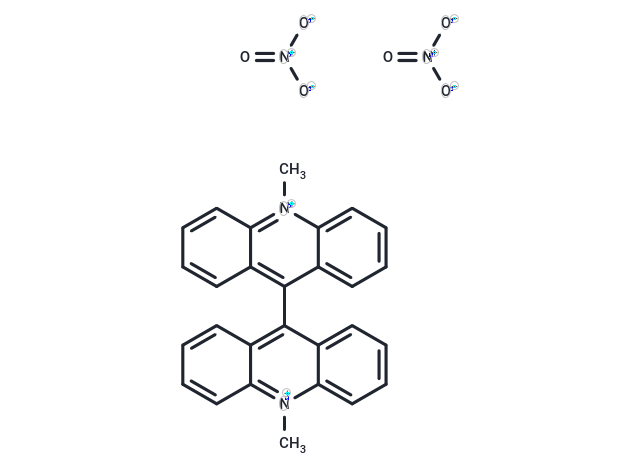Shopping Cart
Remove All Your shopping cart is currently empty
Your shopping cart is currently empty
Lucigenin (NSC-151912) (L-6868) is a chemiluminescent probe used to indicate the presence of endogenously generated superoxide anion radicals in cells.

| Pack Size | Price | USA Warehouse | Global Warehouse | Quantity |
|---|---|---|---|---|
| 50 mg | $29 | In Stock | In Stock | |
| 1 mL x 10 mM (in DMSO) | $29 | In Stock | In Stock |
| Description | Lucigenin (NSC-151912) (L-6868) is a chemiluminescent probe used to indicate the presence of endogenously generated superoxide anion radicals in cells. |
| In vitro | Upon single-electron reduction of Lucigenin by a radical species the subsequent form of Lucigenin presents amplified chemiluminescence which is measurable and can be correlated to the respective amount of reactive radical species present in the system. In addition to indicating the presence of radicals in cells, Lucigenin shows interaction with redox-active oxidoreductase enzymes. Lucigenin is shown to mediate the reduction of cytochrome C by xanthine oxidase and to increase the rate of NADPH oxidation. |
| Cell Research | Instructions 1. Prepare Lucigenin Solution: Dissolve Lucigenin in an appropriate solvent (e.g., PBS or HEPES buffer) at a concentration of 10–50 µM, which can be optimized based on experimental requirements. The solution should be prepared and used immediately, and avoid long-term storage to prevent degradation. 2. Experimental Preparation: Inoculate cells in a suitable culture dish or microplate (usually a 96-well plate). Treat cells to induce the generation of superoxide anion radicals (e.g., by adding specific stimuli or drugs). 3. Add Lucigenin: Add Lucigenin solution (1~10uM) to the cell culture system, ensuring that it is incubated with the stimuli. Usually incubate at 37°C for 10–60 minutes, which can be optimized based on the experiment. 4. Chemiluminescent Detection: Use a chemiluminescent detection instrument (e.g., a microplate reader or a fluorometer) to measure the luminescent signal. The intensity of chemiluminescence is proportional to the amount of superoxide anions produced. 5. Data analysis: Compare the luminescence intensity of the experimental group with that of the control group to evaluate the level of superoxide anion production. Antioxidants or enzymes (such as superoxide dismutase, SOD) can be combined for verification experiments. |
| Synonyms | NSC-151912, L-6868 |
| Molecular Weight | 510.5 |
| Formula | C28H22N4O6 |
| Cas No. | 2315-97-1 |
| Smiles | [O-][N+]([O-])=O.[O-][N+]([O-])=O.C[n+]1c2ccccc2c(-c2c3ccccc3[n+](C)c3ccccc23)c2ccccc12 |
| Relative Density. | no data available |
| Color | Yellow |
| Appearance | Solid |
| Storage | keep away from direct sunlight | Powder: -20°C for 3 years | In solvent: -80°C for 1 year | Shipping with blue ice/Shipping at ambient temperature. | |||||||||||||||||||||||||||||||||||
| Solubility Information | DMSO: 80 mg/mL (156.71 mM), Sonication is recommended. | |||||||||||||||||||||||||||||||||||
| In Vivo Formulation | 10% DMSO+40% PEG300+5% Tween-80+45% Saline: 3.3 mg/mL (6.46 mM), Sonication is recommeded. Please add the solvents sequentially, clarifying the solution as much as possible before adding the next one. Dissolve by heating and/or sonication if necessary. Working solution is recommended to be prepared and used immediately. The formulation provided above is for reference purposes only. In vivo formulations may vary and should be modified based on specific experimental conditions. | |||||||||||||||||||||||||||||||||||
Solution Preparation Table | ||||||||||||||||||||||||||||||||||||
DMSO
| ||||||||||||||||||||||||||||||||||||
| Size | Quantity | Unit Price | Amount | Operation |
|---|

Copyright © 2015-2026 TargetMol Chemicals Inc. All Rights Reserved.